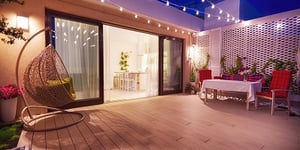
Clients are always in search of clever space utilization to expand or develop the space they have. Outdoor living spaces have really grown in popularity in the last decade and decks have seen some really great innovations in terms of design, function, and materials used. Now it’s time to “level up” your decks by taking deck applications to the roof. But rooftop decks come with special considerations. Here are some issues you need to address when adding rooftop decks to your repertoire.
Local Laws & Limitations
Before you get a client on board with your rooftop deck plans, be sure they’re allowed to have one in the first place. First, check with the building commission on city zoning laws. Second, find out if your client has a homeowner’s association. If they do, then there will likely be rules or approvals needed.
Assess the Load
The next step after finding out if you can build a rooftop deck is to determine if you should. First, you need a flat roof space as rooftop decks are essentially a floating deck style that sits on top of the available space, without being secured to the substructure. Second, look at the structural support available on the roof. Can the roof framing bear the weight of a deck, plus occupants and furniture? You may need to consult a master builder or structural engineer to make this assessment adequately.
Pick the Right Framing
There are a few options for rooftop deck framing. First is the traditional wood framing you’d use on a standard deck project. While this is the most affordable, and likely the style you’re most comfortable building, the concern is that it may create too much weight. The second option are sleepers which are extra pieces of wood added to a wooden deck frame that allow ventilation and drainage while also giving a structure to attach the decking to. The third, and most expensive option is a pedestal system that generally includes an aluminum frame rested upon the lower roof substructure that can be adjusted for leveling. These are not only warp, rot, and twisting resistant, they also are very lightweight compared to the other two options. Make the decision from framing based on both budget and demands of the structure.
Decking Choice
The decking you choose will be critical to the life of your deck. Consider that the demands on a rooftop deck are far greater than one on the ground – less ventilation, low clearance from the surface below, and maximum exposure to sun and the elements. Pressure-treated wood is likely to need a lot of maintenance and upkeep to make it last. Composite decking can be a more lasting option, but some composite options can absorb a lot of heat, leaving your roof deck surface unsuitable for bare feet. High-density hardwoods may be the best option, although unfortunately the most expensive.
Always Fasten Smartly
No matter what materials you choose based on the space and your budget, be sure to use a fastening system that is designed for ease of application and a hold that lasts. The SCRAIL® InvisiDeck® Hidden System from BECK America combines a specialized pneumatic tool with patented nose design, InvisiDeck® I-CLP Clips for blind fastening of grooved boards, and SCRAIL® fasteners designed for a flawless finish of hidden decking fasteners. Get your decking business “off the ground,” literally, by adding rooftop decks to your services this Summer.
.svg.png)

